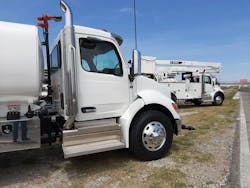Since the mid-1990s Peterbilt’s medium-duty conventional-cab trucks have been built to be reliable and long-lived. Indeed, 95 percent of them are still at work, some in their fourth lives, said Phil Hall, current segment manager for Peterbilt and a presenter at a ride-and-drive event for trade press reporters this week at the Texas Motor Speedway. Drives weren’t on the long NASCAR-spec oval track, but on an infield portion of the complex where 41 mph was as fast as this writer pushed one truck during a hammer-down acceleration run in a Class 6 Model 336 that was soon interrupted by a tight right-hand corner. It was one of several trucks sampled and photographed during the early afternoon activity that followed briefings on the new midrange products.
The restyled and redesigned models cover Class 5 through Baby 8, and are numbered Peterbilt 535, Peterbilt 536, Peterbilt 537, and Peterbilt 548. They will replace the 300 series that will phase out later this year. The 500 series’ most notable feature is a 2.1-meter-wide cab borrowed from certain heavy-duty Peterbilts and shared with Kenworth, a corporate sister, which showed off its new midrange models a few weeks earlier. The cab is 8 inches wider than that on the outgoing models.
“The 1.9-meter cab wasn’t wide enough,” Hall said, citing research done with customers’ drivers who explained their varying duties that involved frequently climbing in and out of cabs and motoring through urban and suburban locales. “So we rethought it” in the course of five years of development of the medium-duty replacements. Additional room in the wider cabs allow three-person seating with an optional two-place bench seat, and more storage. A new instrument cluster, strong composite dashboards and easy-to-reach switches and controls should also make the new trucks more desirable to buyers.
Both medium-duty conventional lines are assembled at a Paccar plant in St. Therese, Quebec, outside of Montreal, and might be presumed to be all but identical except for nameplates. Not so, Hall insisted, for Peterbilt retained certain product details in the design process during which specialists from both builders collaborated. Instruments are illuminated in amber, which is easier on drivers’ eyes than the blue used on the rival sister’s gauge cluster. The Petes also have doors with near-level window sills instead of the drop-down sills that are KW trademarks.
Mirror mounts on the Petes are on the cowl, ahead of the doors, where vibration is low so sight pictures in mirror glass are steady, and the mounts will break away but not shatter in a minor collision. A 250-pound showoff can do pullups on a mirror mount, Hall said, but didn’t demonstrate. The grille includes three vertical bars that are carefully shaped to reflect light so the truck is identifiable as a Peterbilt as it approaches. Not so with an optional flat-black grille aimed at “work truck” buyers who distain chrome and the lavish spending it might represent.
Like Kenworth, Peterbilt is using a new ZF-made eight-speed automated transmission and Paccar-branded diesels sourced from Cummins. Engines are the 6.7-liter PX-7, with ratings of 230 and 260 horsepower, and the 8.9-liter PX-9, with ratings up to 360 horsepower. The sure-shifting TX-8 is smooth and unobtrusive in operation, and the smaller diesel rather gutsy; though the trucks were empty they’d probably move well while loaded, too. Several larger Pete midrange models mounted with vocational apparatus were displayed but not available for drives.
Also shown were a Peterbilt 579 over-the-road tractor and an updated Peterbilt 567, its principal vocational model, that have used the wide cab since the mid-teens. The 567’s current popularity with construction fleets should be boosted with refinements like a new “digital dash” that displays road speed, engine revs, engine condition numbers and much additional information on a large 15-inch color screen. It will become standard on 567s and 579s this summer.





